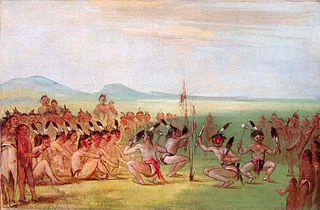
American literature is literature written or produced in the United States of America and in the colonies that preceded it. The American literary tradition thus is part of the broader tradition of English-language literature, but also includes literature of other traditions produced in the United States and in other immigrant languages.

Gerald Robert Vizenor is an American writer and scholar, and an enrolled member of the Minnesota Chippewa Tribe, White Earth Reservation. Vizenor also taught for many years at the University of California, Berkeley, where he was Director of Native American Studies. With more than 30 books published, Vizenor is Professor Emeritus at the University of California, Berkeley, and Professor of American Studies at the University of New Mexico.

The stomp dance is performed by various Eastern Woodland tribes and Native American communities in the United States, including the Muscogee, Yuchi, Cherokee, Chickasaw, Choctaw, Delaware, Miami, Caddo, Tuscarora, Ottawa, Quapaw, Peoria, Shawnee, Seminole, Natchez, and Seneca-Cayuga tribes. Stomp dance communities are active in Georgia, North Carolina, Oklahoma, Alabama, Mississippi, and Florida.

Jamake Highwater was an American writer and journalist of Eastern European Jewish ancestry who mispresented himself as Cherokee.
LeAnne Howe is an American author and Eidson Distinguished Professor in the Department of English at the University of Georgia, Athens. She previously taught American Indian Studies and English at the University of Minnesota and at the University of Illinois at Urbana-Champaign.
Louis Dean Owens was a novelist and scholar who claimed Choctaw, Cherokee, and Irish-American descent. He is known for a series of Native-themed mystery novels and for his contributions to the then-fledgling field of Native American Studies. He was also a professor of English and Native American studies, and frequently contributed articles, literary criticism and reviews to periodicals. Owens died by suicide in 2002.

The Choctaw freedmen are former enslaved African Americans who were emancipated and granted citizenship in the Choctaw Nation after the Civil War, according to the tribe's new peace treaty with the United States. The term also applies to their contemporary descendants.
Apuckshunubbee was one of three principal chiefs of the Choctaw Native American tribe in the early nineteenth century, from before 1800. He led the western or Okla Falaya District of the Choctaw, of which the eastern edge ran roughly southeast from modern Winston County to Lauderdale County, then roughly southwest to Scott County, then roughly south-southeast to the western edge of Perry County. His contemporaries were Pushmataha and Moshulatubbee, who respectively led the southern district Okla Hannali and the north-eastern district Okla Tannap.

In mythology and the study of folklore and religion, a trickster is a character in a story who exhibits a great degree of intellect or secret knowledge and uses it to play tricks or otherwise disobey normal rules and defy conventional behavior.

Red Shoes was a Choctaw chief who traded with British fur traders based in South Carolina in the 1740s and ignited the Choctaw Civil War. The French countered by arranging the assassination of Red Shoes. He was also known as Red Moccasin and was known in French as le Soulier Rouge.
The Native Writers' Circle of the Americas (NWCA) is an organization of writers who identify as being Native American, First Nations, or of Native American ancestry.

Bearheart: The Heirship Chronicles is a 1990 novel by Gerald Vizenor; it is a revised version of his 1978 debut novel Darkness in Saint Louis: Bearheart. The novel is a part of the Native American Renaissance and is considered one of the first Native American novels to introduce a trickster figure into a contemporary setting. Vizenor drew from trickster traditions from various Native American tribes, such as Nanabozho (Anishinaabe) and Kachina (Pueblo).
Griever: An American Monkey King in China is a 1986 novel by Gerald Vizenor. It won the 1986 New York Fiction Collective Award and the 1988 American Book Award. The book is important both because it establishes the trickster figure of Griever de Hocus, whom Vizenor had created in his 1985 story "Luminous Thighs" and whom he would use again in The Trickster of Liberty, and because Vizenor takes Native American stories and themes outside the Americas and into China, establishing a connection to Chinese trickster figures, most notably Sun Wukong the Monkey King.
The Trickster of Liberty is a 1988 novel by Gerald Vizenor that acts as a prequel to his earlier novels Bearheart: The Heirship Chronicles and Griever: An American Monkey King in China. The novel is a collection of stories about the mixedblood descendants of Luster Browne and their lives on the White Earth Indian Reservation. The novel continues Vizenor's focus on mixedbloods and tricksters and includes characters from the previous novels, including Griever de Hocus and China Brown from Griever and Eternal Flame from Bearheart.

Eric Gansworth is a Haudenosaunee novelist, poet and visual artist.
Linda LeGarde Grover is an Anishinaabe novelist and short story writer. An enrolled member of the Bois Forte Band of the Minnesota Chippewa Tribe, she is a professor of American Indian Studies at the University of Minnesota Duluth, as well as a columnist for the Duluth News Tribune.

The Choctaw Civil War was a period of economic and social unrest among the Choctaw people that degenerated into a civil war between 1747 and 1750. The war was fought between two different factions within the Choctaw over what the tribes's trade relations with British and French colonists should be. Hundreds of Choctaw died in the war and the pro-French faction retained their influence within the Choctaw nation.
Native American nations, Irish immigrants to the United States, and residents of Ireland have a history of often-supportive interactions dating back to the start of the Great Famine. Across multiple generations, people from both communities have drawn attention to their parallel histories of colonization by English-speaking countries. Scholarship on, and press attention to, these interactions has highlighted both acts of solidarity and the participation of some Irish immigrants in the invasion and dispossession of Native Americans.










